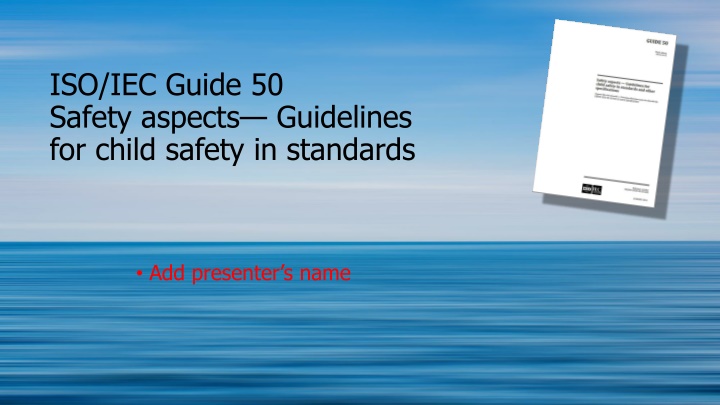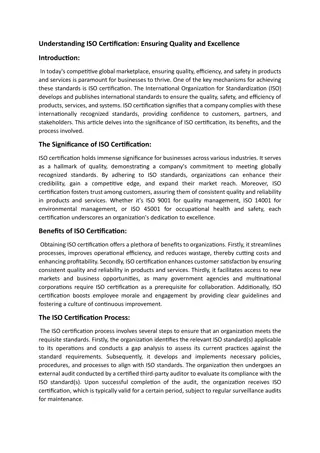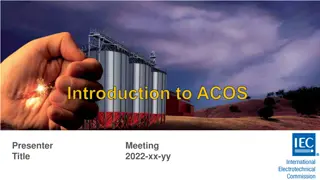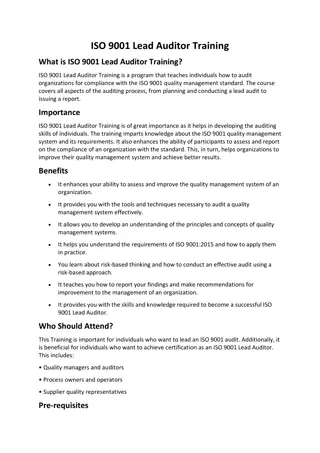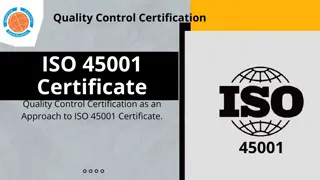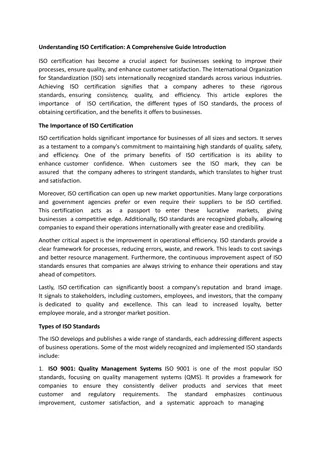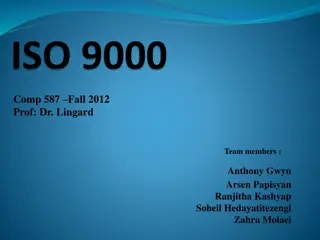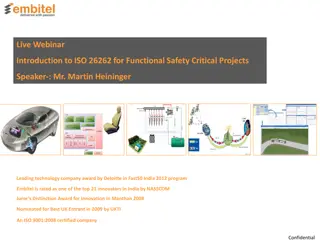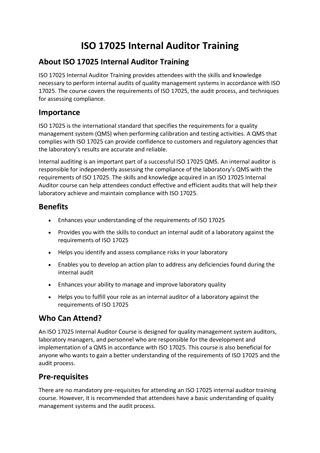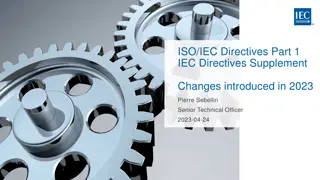Guidelines for Child Safety in Standards: An Overview of ISO/IEC Guide 50
Child safety is a critical concern globally, with unintentional injuries being a leading cause of death for children over the age of 5. The ISO/IEC Guide 50 provides essential safety aspects and guidelines to address this issue, emphasizing the importance of balancing safety with children's need for exploration and learning. The guide covers historical background, terms like harm, hazard, and risk, and why it is necessary to consider child-specific characteristics when designing and manufacturing products.
Download Presentation

Please find below an Image/Link to download the presentation.
The content on the website is provided AS IS for your information and personal use only. It may not be sold, licensed, or shared on other websites without obtaining consent from the author.If you encounter any issues during the download, it is possible that the publisher has removed the file from their server.
You are allowed to download the files provided on this website for personal or commercial use, subject to the condition that they are used lawfully. All files are the property of their respective owners.
The content on the website is provided AS IS for your information and personal use only. It may not be sold, licensed, or shared on other websites without obtaining consent from the author.
E N D
Presentation Transcript
ISO/IEC Guide 50 Safety aspects Guidelines for child safety in standards Add presenter s name
A major child health issue Child safety is a major concern for society, because child and adolescent injuries are a major cause of death and disability in most countries. The joint WHO/UNICEF World Report on Child Injury Prevention identifies unintentional injury as the leading cause of death for children over the age of 5. More than 830 000 children die each year from road traffic crashes, drowning, burns, falls and poisoning. Preventing injuries is a shared responsibility The challenge is to develop products, including manufactured articles, processes, structures, installations, services, built environments or a combination of any of these which minimize the potential for causing deaths or serious injuries to children. A significant aspect of this challenge is to balance safety with children s need to explore a stimulating environment and learn. Injury prevention can be addressed through design, engineering, manufacturing controls, legislation, education and raising awareness.
An overview of Guide 50 ISO/IEC Guide 50 History First published in 1987 Second edition published in 2002 Third edition published in December 2014 Closely associated with ISO/IEC Guide 51 Safety aspects Guidelines for their inclusion in standards
Harm, hazard and risk Important to understand some terms used taken from Guide 51 Harm: injury or damage to the health of people, or damage to property or the environment Hazard: potential source of harm Risk: combination of the probability of occurrence of harm and the severity of that harm Tolerable risk: level of risk that is accepted in a given context based on the current values of society Products Guide 50 refers to products Wider definition than just manufactured articles and consumer products Shorthand for manufactured article, process, structure, installation, service, built environment or a combination of any of these. Also includes packaging (whether or not it is intended or likely to be retained as part of the product) as this can cause harm
Why is Guide 50 needed ? 1. Children interact with products in various ways: intentionally and actively, for example, toys, playground equipment, clothes intentionally but passively, for example, nursery equipment (cots, high chairs, feeding items, etc), child car seats, school furniture These products normally take children s characteristics and behaviours into account 2 Children also interact with, including intentionally use, other products , actively or passively, for example: consumer products, structures and systems cookers, house design features (stairs, doors, heating systems), cleaning products, televisions, product packaging, electrical installations public structures and systems transport systems, public buildings, (polluted) air, water storage systems These products do not always take children s characteristics and behaviours into account, and can cause harm to children. The use might not be in the way that the manufacturer intended. THEREFORE we need to take children s characteristics and behaviours into account: Risk assessment is needed to consider whether and how children might interact with products , and the consequences of any interactions Children are not a homogeneous group their characteristics and behaviours vary considerably during childhood Children are subject to a range of cultural differences, including the degree of supervision
What is Guide 50? Short text book Guidance document for standards writers and others This Guide provides guidance to those developing and revising standards, specifications and similar publications. However, it contains important information that can be useful as background information for, amongst others, designers, architects, manufacturers, service providers, educators, communicators and policy makers. What Guide 50 is not: It is NOT a document about products specifically intended for children it has far wider relevance This Guide does not provide guidance on the prevention of intentional harm (e.g. child abuse) or nonphysical forms of harm, such as psychological harm (e.g. intimidation). This Guide does not address the economic consequences of the above.
ISO/IEC Guide 50 Structure and content A general approach to child safety, including the principles for a systematic way to address hazards The relationship between child development and behaviour and unintentional injury, including children s anthropometry motor, physiological and cognitive development exploration strategies The importance of applying knowledge of child development and behaviour to preventing harm The relevance of the child s physical and social environments Special considerations relating to the child s sleeping environment A detailed look at the hazards to which children might be exposed during their use of or interaction with a product , along with specific suggestions for addressing the hazards. These hazards are also listed in ISO/IEC Guide 51 but in Guide 50 the focus is on the specific risk to children associated with the hazards. A structured means of considering safeguards
General approach to child safety Harm Harm can result from hazards such as: deprivation of vital needs, (e.g. oxygen, such as by drowning or suffocation) transfer of energy (e.g. mechanical, thermal, electrical, radiation) exposure to agents (e.g. chemical, biological) greater than the body s capacity to withstand Harm can be prevented or reduced by intervening in the chain of events leading to, or following, their occurrence Strategies for preventing and reducing harm Strategies may include one or more of the following: eliminating the hazard and/or exposure to the hazard (primary prevention, e.g. designing safer products - substituting non- flammable liquid for a flammable one, etc) eliminating exposure to the hazard (primary prevention) reducing the probability of exposure to the hazard (secondary prevention, e.g. using child-resistant packaging) reducing the severity of harm (secondary prevention, e.g. use of personal protective equipment, or reduction of temperature of domestic hot water) reducing the long-term effects of harm through approaches such as rescue, treatment or rehabilitation (tertiary prevention)
General approach to child safety Passive and active strategies Passive strategies work without the individual having to take any action to be protected. Active strategies require the individual to take some action to minimize the harm. Passive strategies that eliminate or guard against a hazard ensure a greater likelihood of success than active strategies. Whenever possible, product design should aim to incorporate passive prevention strategies. Improving product safety should start at the product design stage, aiming to incorporate a primary prevention approach or, if this is not possible, a secondary prevention approach.
General approach to child safety Sources of information to assess the potential for harm These include but are not limited to: injury statistics detailed information available from injury surveillance systems research results test data (although passing a test does not necessarily mean a product is free of hazards) investigations of case reports complaint data extrapolation of relevant data about hazardous characteristics from other types of products Surveillance data, recalls, and other similar actions in other jurisdictions should also be considered. CAUTION The absence of reported harm does not necessarily mean that there is no hazard
General approach to child safety The need to disaggregate injury data As harm to children is generally closely related to their developmental stage and their exposure to hazards at various ages, it is important to sort child injury data by age group to identify the patterns that emerge. Examples: Burns from oven doors, scalds, poisoning by medicines and household chemicals, and drowning peaks among children under 5 years of age. Injuries associated with falls from playground equipment peak at 5 to 9 years. Injuries associated with falls and impacts related to sports peak at 10 to 14 years.
General approach to child safety Children with disabilities A small but significant proportion of children have disabilities. Disabilities includes a wide range of conditions, varying in their nature, severity and impact Requirements to meet their needs, in addition to those outlined in this Guide, might be appropriate, although there might be situations when generic approaches are not possible and individual approaches are required. For these reasons, advice from specialists should be sought. This Guide does not provide detailed advice on how to minimize the risk and/or severity of unintentional injuries among children with disabilities. Refer to ISO/IEC Guide 71 Guide for addressing accessibility in standards.
Safety considerations: child development, behaviour, and unintentional harm Child development and behaviour Children are not small adults. Inherent characteristics of children, including their stage of development, together with their exposure to hazards, puts them at risk in ways different from adults. Developmental stage broadly encompasses children s size, shape, physiology, physical and cognitive ability, emotional development and behaviour. These characteristics change quickly as children develop. Parents and other carers often overestimate or underestimate children s abilities at different stages of development, thus exposing them to hazards. This situation is compounded by the fact that much of the environment that surrounds children is designed for adults. Childhood characteristics Childhood characteristics can act in combination, increasing the child s risk. For example: exploratory behaviour might lead a child to climb a ladder limited cognitive skills might prevent the child from recognizing that the ladder might be too high or unstable limited motor control might result in the child losing grip and falling Safety considerations should provide an appropriate balance between risk and freedom for children to explore a stimulating environment and to learn. The goal is to reduce the risk of harm by design in accordance with their level of development.
Safety considerations: child development, behaviour, and unintentional harm Use and misuse The way children use and interact with products should be considered normal childhood behaviour. The term misuse is misleading, and can lead to inappropriate decision-making regarding child hazards. For example, survey evidence shows that children regularly use products that were not designed for them, such as microwave ovens. When a child interacts with a product, it is difficult to make a distinction between play, active learning or intended use. For safety reasons, it is not constructive to attempt to distinguish between such interactions. Children s body size and anthropometric data Certain characteristics of children s size and weight distribution make them particularly vulnerable to harm. The nature of this harm might also be different from that experienced by adults.
Safety considerations: child development, behaviour, and unintentional harm Chronological age compared with developmental age When considering the risks that children face, one should be aware that chronological age does not always match developmental age, i.e. children of the same chronological age might developmentally differ significantly. For example: within a single narrow age range, some 12 month old babies may be able to walk while others are still crawling. a small proportion of 4 year olds can open containers that are certified as child-resistant while the majority cannot. some 8 year olds will follow rigid patterns of behaviour when crossing a road while others might behave unpredictably.
Safety considerations: child development, behaviour, and unintentional harm Examples where body size and weight distribution are factors in harm Thermal injuries: a given area of contact is typically a larger proportion of a child s surface area than is the case for an adult. overall larger surface-area-to-body mass ratio can result in a greater proportion of body fluids being lost from the burnt area. Head Size: Young children have a large head compared with their body size high centre of mass increases the likelihood of falls, e.g. from furniture or structures children often fall directly onto their head. increases the likelihood of falling into pools, buckets, toilets, bathtubs, etc., into which children are bending or reaching, thereby increasing the risk of drowning. requires a much larger space to pass through than the rest of the body. Entrapment can occur when the body passes, feet first, through a gap through which the head cannot. relatively large mass of the head increases the likelihood and severity of whiplash. a given area of contact is typically a larger proportion of a child s surface area than is the case for an adult. overall larger surface-area-to-body mass ratio can result in a greater proportion of body fluids being lost from the burnt area. Other issues: Children might be able to insert their fingers, hands or other parts of their body into small openings and gaps to access rotating and moving parts or electrical and other hazards. Small quantities of substances that would not harm an adult can harm a child. They might be more strongly affected than adults by exposure to chemical and radiation hazards due to their large surface-to-mass ratio as well as their small body size.
Safety considerations: child development, behaviour, and unintentional harm Motor development Maturation process of gross (whole body) and fine (hand and finger) movements and coordination Changes from involuntary reflex actions to deliberate, goal-directed actions Examples of milestones (not in order): support the head crouch sit up roll over crawl stand climb rock walk and run ability to manipulate objects with hands and fingers Examples where motor development can be a factor in harm Babies can move to the edge of a surface and roll off Unable to lift themselves up - can become wedged between products and suffer positional or compression asphyxia. From about three months, infants placed to sleep on their backs can turn over and suffocate if the mattress or bedding is too soft. Standing babies and toddlers can become entangled in cords, ribbons, or window coverings within their reach. When they sit or slump, the cords can tighten around their neck, resulting in strangulation. Climbing children can get clothing, accessories, and anything they wear (e.g. backpack, hair accessory) caught in furniture items or protrusions. They can hang. Children can fall from heights because they lose their balance or grip.
Safety considerations: child development, behaviour, and unintentional harm Physiological development Sensory functions Biomechanical properties Reaction time Metabolism Organ development Visual development Slower than development of other senses Even when most children have vision similar to that of adults, they might have narrower vision or have difficulty with depth perception. As a result, children will have difficulty recognizing hazardous situations.
Safety considerations: child development, behaviour, and unintentional harm Examples where physiological development can be a factor in harm Small body size and faster breathing rates result in their being particularly susceptible to potentially toxic substances such as medications, chemicals and plants. Biochemistry makes them susceptible to toxicity of chemicals, medications and plants not toxic to adults. Characteristics of children s skin, including its thinness, make it more vulnerable to thermal injury. Bones are not fully developed, resulting in different responses to mechanical forces. More susceptible to harm from intense light sources. More sensitive to sound pressure.
Safety considerations: child development, behaviour, and unintentional harm Cognitive development Determines their ability or inability to understand the consequences of their actions. Young children have limited ability to recognize hazards do not consistently and reliably anticipate or respond to harmful consequences of hazardous conditions. Hazards obvious to adults are not so obvious for children. Exploration strategies From early infancy, children are driven by an inborn drive to explore. One of the most frequently observed exploration strategies is object manipulation Mouthing not just about eating; feelings of pleasure; relief from teething pain More complex two-handed coordination learning about physical properties; rotating, dropping, throwing, etc While children are capable of perceiving some risk, they are not able to assess the risk involved in a potentially hazardous situation until they are capable of understanding consequences (cause and effect) at around 7 to 8 years old.
Safety considerations: child development, behaviour, and unintentional harm Examples of exploration strategies: Exploration strategy Age peak Mouthing Rotating Transferring from hand to hand Inserting body into object Inserting object into body Banging Dropping Throwing Imaginative play Testing the limits Birth to 3 years 6 months to 2 years 9 months to 2 years 6 months to 10 years 2 to 6 years 9 months to 5 years 6 months to 3 years 1 to 4 years 3 to 10 years 3 to 10 years
Safety considerations: child development, behaviour, and unintentional harm Applying knowledge of child development to preventing harm When developing or revising a standard for a product, reasonably foreseeable use by children should be taken into account. For example: Children will be attracted to flashing lights, sound, and buttons. Children often mimic adults, older children and media characters: this leads children to use products normally used by adults and not intended for them. This behaviour is dangerous when children do not understand the implications of their actions. Packaging, especially if it is colourful and attracts children (e.g. the shape of a toy), is likely to result in the child using that product imaginatively. Children cannot be expected to recognize the difference between a real object and an imitation or model, either of which can be harmful. The use on products of images which might be attractive to children, such as cartoon characters, or products which are themselves designed to look like cartoon characters, e.g. hairdryers, lanterns and cigarette lighters, might induce children into treating them as playthings.
Safe environments Environments that can affect safety The physical and social environment affect how a child interacts with a product Natural and built environments, climate, language, customs, attitudes and beliefs, knowledge and users experience all affect product safety The likelihood and severity of injuries can be increased by the presence and involvement of more than one child Physical environment Products may be used in multiple environments A product might be used in an environment other than intended, for example: a popup camping tent set up indoors as a playhouse a trampoline used indoors indoor electrical devices used outside outdoor generators run indoors indoor activity sets installed outdoors with the threat of weathering medical devices used in the home environment, e.g. oxygen bottles, defibrillators, hospital beds fireworks intended for outdoor use are sometimes used indoors or in partly-enclosed spaces
Safe environments Social environment Down-aging - often referred to as children getting older younger . The trend is for younger children to use clothes and footwear, jewellery, simulated piercings, makeup and digital electronic devices historically used by older persons. The relationship between parents and other carers and children can be expected to vary with geographic, cultural/ethnic and socio-economic differences. As children approach adolescence, peer pressure and risk-taking can affect the use or consumption of products. Sleep environment Children spend a great deal of time in their bedroom The prolonged absence of supervision makes this an unusual and special environment. Other children in the same room which increases the potential for harm. The cot, bed, or other sleep product, as well as the child s immediate environment, should be safe not only when the child is sleeping, but also when awake prior to or after sleep when they might be unsupervised for an extended period of time. Products commonly used in conjunction with the cot/bed, furniture and fittings, and other items such as clothing and toys, should also be considered.
Hazards relevant for children General issues New hazards can emerge and enter children s environments due to developing technology and changes in lifestyle Essential to consider the context in which it will be used. For example, if a product is tested in a situation that is not typical of how it will be used in reality, its performance in real life can differ. When a product is intended to be or might be used in combination with another product, such as a seat used by babies in a bath, the performance of both systems in combination should be examined to minimize risk and ensure no new hazards are introduced. A product can cause death or injury at various stages of its life cycle, including beyond its useful or intended life.
Hazards relevant for children Mechanical and fall hazards Fall and other impact injuries Drowning hazards Suffocation hazards Strangulation hazards Small objects and suction hazards Fire hazards Thermal hazards Chemical hazards Electric shock hazards Radiation hazards Hazards from noise (sound pressure) Biological hazards Explosion and fire flash hazards For each hazard General commentary Examples of how injuries can occur Examples of strategies to prevent or reduce injuries
Examples from hazards chapter Mechanical hazard sharp edges and points General commentary - Many of the products that children encounter in the domestic and educational environment are intended to be sharp or pointed to meet their functional needs (e.g. knives, needles, kitchen equipment or tools used in the garden or garage). Examples of how injuries can occur - It is normal behaviour for children to put a sharp object in their mouths and to walk and run about when carrying them in this way. Examples of strategies to prevent or reduce injuries - Avoiding, guarding or curving exposed edges to reduce the risk of laceration; restricting children s access to sharp parts of tools by appropriate guarding or by making the tool difficult for a child to operate Mechanical hazards stability General commentary - A product that is not sufficiently stable might fall over, injuring a child who is in, climbing on, or near it. The nature of the harm can vary depending on the function of the product. For example, crush injuries from falling furniture or televisions, etc. Examples of how injuries can occur - Tall, top-heavy or wheeled furniture, such as television stands, cause a risk when children pull or push them. Examples of strategies to prevent or reduce injuries - designing products with such features as low centre of mass, position of contact points with the supporting surface so that they can withstand any foreseeable destabilizing loads; providing anchoring devices for potentially unstable products.
Examples from hazards chapter Fire hazards open flames General commentary - While open flames, e.g. from fireplaces and candles, are an obvious hazard to adults, they can attract children. This play behaviour might be due to attraction to the flame or lighter, or be an attempt to imitate adult behaviour. Examples of how injuries can occur - Children have been badly burned and caused house fires when playing with cigarette lighters. Examples of strategies to prevent or reduce injuries - incorporating features to make it difficult for a child to operate (i.e. child-resistance) into the design of cigarette lighters and other sources of ignition; avoiding designing lighters and other sources of ignition with appearances that are attractive to children (e.g. resembling familiar cartoon characters or toys). Suffocation hazards flexible materials General commentary - Materials that do not allow air to pass constitute a suffocation risk, in particular for young children. During play, they might put the material or object over their face or head or lie on top of it. Examples of how injuries can occur - Suffocation and irreversible brain injury can occur when children place plastic bags over their head or face. Examples of strategies to prevent or reduce injuries - limiting the size of flexible materials so that they cannot cover the nose and mouth; providing ventilation holes.
Adequacy of safeguards Social environment Down-aging - often referred to as children getting older younger . The trend is for younger children to use clothes and footwear, jewellery, simulated piercings, makeup and digital electronic devices historically used by older persons. The relationship between parents and other carers and children can be expected to vary with geographic, cultural/ethnic and socio-economic differences. As children approach adolescence, peer pressure and risk-taking can affect the use or consumption of products. Safeguards A safeguard can be applied to the product, the local installation, a person, or can be a learned or directed behaviour (e.g. resulting from an instructional safeguard). Thus, a safeguard encompasses more than simply a protective device, and can involve one or more strategies and/or behaviours.
Adequacy of safeguards Order of preference Product safeguards, since they do not require any knowledge or actions by persons coming into contact with product; for example, on a ride-on toy, the brake is automatically applied when a child removes his or her foot from the accelerator; sometimes protective devices are designed for segments of the population excluding children. When these devices operate, they can present a hazard to babies and children., e.g. air bags in cars Installation (including assembly and maintenance) safeguards when a safety characteristic can only be provided after installation (e.g. the product should be bolted to the floor to provide stability). Personal and behavioural safeguards when there is a functional need for an energy source to be accessible; a personal safeguard (also referred to as a personal protective device) is often a physical device worn on the body; for example, helmets, sunglasses, safety gates; a problem can arise when products which resemble protective devices but which provide no protection are also available. These products are often toys, e.g. toy helmets or toy sunglasses. Instructional safeguards to warn users about a hazardous energy source or to instruct a specific behaviour when such a behaviour is not commonly expected to be available. Information should be legible, understandable and available during the time or occasion when the corresponding hazard might occur, e.g. by making the instruction manual available for downloading from a supplier s website.
ISO/IEC Guide 50 is freely available from www.iso.org at: http://www.iso.org/iso/home/store.htm from www.iec.ch at: https://webstore.iec.ch/publication/11940
